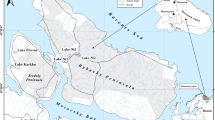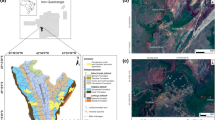Abstract
The paper presents data on the chemical composition of waters and bottom sediments in lakes variably affected by liquid wastes from facilities of the Olkon Joint-Stock Company in Olenegorst, Murmansk oblast, which mines and processes iron ores. Since Olkon started operating, the composition of water in nearby water bodies has underwent significant changes. The mineralization (TDS) and pH of the lacustrine waters have increased (to 100 mg/L and 7.6 respectively). The qualitative composition of the water has also changed (the water type has changed from hydrocarbonate to sulfate), as also have the proportions of the dominant cations. The waters of the lakes have enriched in nitrogen-group compounds. The \({\text{NO}}_{3}^{ - }\) concentrations in some of the lakes are higher than the concentrations of the dominant ions (Na+, K+, and Cl–) recalculated into equivalent concentrations. The inflow of contaminants with the waste waters has suppressed biological productivity and reduced concentrations of organic compounds in the lacustrine waters. The waters of the lakes that received waste waters form the iron-producing facilities contain the highest Ni, Cu, Co, Al, and Sr concentrations, whereas the Fe concentrations are the lowest, which is reportedly explained by a decrease in the concentrations of organic compounds and an increase in pH of the lacustrine waters (and a corresponding decrease in the Fe solubility). The paper reports data on the speciation of metals in the lacustrine waters: Fe and Cu occur in them mostly in compounds with organic ligands Fe(III)–L and Cu(II)–L; Mn is contained as Mn(II)–\({\text{SO}}_{4}^{{2 - }}\)/Cl–/OH– compounds; and Ni, Co, and Zn form compounds with hydroxyl groups Ni(II)–OH, Co(II)–OH, and Zn(II)–OH. Concentrations of heavy metals in the lacustrine bottom sediments depend on the dominant form of their occurrence in the waters. The surface layers of the bottom sediments are significantly enriched in heavy metals (Ni, Cu, Co, Cd, Pb, As, Hg, Fe, and Mn), which are tens of times higher than the background concentrations. The highest values of the contamination factor (Cf) and degree of contamination (Cd) were found in the lakes contaminated with waste waters from the facilities.




Similar content being viewed by others
REFERENCES
Atlas of Murmansk Area (Murmansk, 1971) [in Russian].
M. M. Bazova, “Specifics of the elemental composition of waters in environments with operating mining and ore-processing plants in the Kola North,” Geochem. Int. 55 (1), 131–143 (2017).
A. A. Beus, L. I. Grabovskaya, and N. V. Tikhonova, Environmental Geochemistry (Nedra, Moscow, 1976) [in Russian].
V. A. Dauvalter, Geoecology of Bottom Deposits of Lakes (Murm. Gos. Tekhn. Univ., Murmansk, 2012) [in Russian].
V. A. Dauvalter and B. P. Ilyashuk, “Conditions of formation of ferromanganese nodules in the bottom sediments of lakes in the Baltic Shield,” Geochem. Int. 45 (6), 615–619 (2007).
V. A. Dauvalter and N. A. Kashulin, “Assessment of the ecological state of the Arctic freshwater system based on concentrations of heavy metals in the bottom sediments,” Geochem. Int. 56 (8), 842–856 (2018).
V. A. Dauvalter and N. A. Kashulin, “Mercury pollution of Lake Imandra sediments, Murmansk Region, Russia,” Int. J. Env. Res. 12 (6), 939–953 (2018).
V. A. Dauvalter, M. V. Dauvalter, N. V. Saltan, and E. N. Semenov, “The chemical composition of surface water in the influence zone of the Severonikel Smelter,” Geochem. Int. 47 (6), 592–610 (2009).
V. A. Dauvalter, M. V. Dauvalter, N. A. Kashulin, and S. S. Sandimirov, “Chemical composition of bottom sedimentary deposits in lakes in the zone impacted by atmospheric emissions from the Severonickel Plant,” Geochem. Int. 48 (11), 1148–1153 (2010).
V. A. Dauvalter, N. A. Kashulin, and D. B. Denisov, “Trends of heavy metal variations in the bottom sediments of Lakes of Northern Fennoscandia in last centuries,” Tr. Karel’sk. Nauchn. Ts. Ross. Akad. Nauk 9, 62–75 (2015).
M. I. Dinu, Influence of Functional Features of Humus Matters on the Metal Speciation in Natural Waters (Tyum. Gos. Univ., Tyumen, 2012) [in Russian].
M. I. Dinu, “Formation of organic substances of humus nature and their biospheric properties,” Geochem. Int. 55 (10), 911–926 (2017).
D. Gregurek, F. Melcher, V. A. Pavlov, C. Reimann, and E. F. Stumpf, “Mineralogy and mineral chemistry of snow filter residues in the vicinity of the nickel-copper processing industry, Kola Peninsula, NW Russia,” Mineral. Petrol. 65, 87–111 (1999).
L. Håkanson, “An ecological risk index for aquatic pollution control—a sedimentological approach,” Water Res.14, 975–1001 (1980).
Intercomparison-2016 1630: pH, Conductivity, Alkalinity, NO3-N, Cl, SO4, Ca, Mg, Na, K, TOC, Al, Fe, Mn, Cd, Pb, Cu, Ni and Zn. ICP Waters Report 129/2016.(Norwegian Institute for Water Research, 2016), No. 7081.
G. V. Kalabin, A. E. Vorob’ev, A. V. Dzhanyants, and M. G. Salazkin, “Study of anthropogenic impact of iron quarries of European Russia on the environment,” Gorn. Inform.-Analit. Byull. 12, 8–13 (2002).
N. A. Kashulin, S. S. Sandimirov, V. A. Dauvalter, L. P. Kudryavtsev, P. M. Terent’ev, D. B. Denisov, O. I. Vandysh, and S. A. Val’kova, Annotated Ecological Catalogue of Lakes of the Murmansk Area (Eastern Part. White Sea Basin) (Kol’sk. Nauch. Ts., Apatity. 2012) [in Russian].
N. A. Kashulin, V. A. Dauvalter, D. B. Denisov, S. A. Valkova, O. I. Vandysh, P. M. Terentjev, and A. N. Kashulin, “Selected aspects of the current state of freshwater resources in the Murmansk Region, Russia,” J. Environ. Sci. Heal. A. 52 (9), 921–929 (2017).
S. N. Kolmykov, Extended Abstract of Candidate’s Dissertation in Geography (Belgorod, 2008) [in Russian]
L. N. Larichev, and V. V. Cheskidov, “Study of behavior and fixation forms of element pollutants in the bottom sediments of the surface water objects of the mining lease of the Lebedinsky MPP,” Gorn. Inform.-Analit. Byull. 11, 286–299 (2012).
P. A. Lozovik, and N. E. Galakhina, “Chemical variations of water of the Kenti River system in response to anthropogenic impact,” Tr. Karel’sk. Nauch. Ts. Ross. Akad. Nauk 3, 21–35 (2017).
D. N. Malinovsky, I. V. Rodyushkin, E. P. Shcherbakova, C. Ponter, B. Öhlander, and J. Ingri, “Fractionation of Fe isotopes as a result of redox processes in a basin,” Geochem. Int. 43 (8), 797–803 (2005).
A. V. Maslennikova, V. N. Udachin, and V. N. Deryagin, Paleoecology and Geochemistry of the Holocene Lacustrine Sedimentation of the Urals (RIO UrO RAN, Yekaterinburg, 2014) [in Russian].
Mineral Deposits (Nedra, Moscow, 1981) [in Russian].
T. I. Moiseenko, “Impact of geochemical factors of aquatic environment on the metal bioaccumulation in fish,” Geochem. Int. 53(3), 213–223 (2015).
T. I. Moiseenko and N. A. Gashkina, Formation of the Chemical Composition of Lacustrine Waters under Environmetal Changes (Nauka, Moscow, 2010) [in Russian].
T. I. Moiseenko, M. I. Dinu, N. A. Gashkina, and T. A. Kremleva, “Occurrence forms of metals in natural waters depending on water chemistry,” Water Res. 40 (4), 407–416 (2013).
T. I. Moiseenko, V. A. Dauvalter, A. A. Lukin, L. P. Kkudryavtseva, B. P. Ilyashuk. S. S. Sandimirov, L. Ya. Kagan, O. I. Vandysh, A. N. Sharov, Yu. N. Sharova, and I. M. Koroleva, Anthropogenic Modifications of the Lake Imandra Ecosystem (Nauka, Moscow, 2002) [in Russian].
Yu. N. Neradovsky, V. A. Dauvalter, and E. E. Savchenko, “Genesis of framboidal pyrite in the modern lacustrine sediments (Kola Peninsula),” Zap. Ross. Mineral. O-va 6, 50–55 (2009).
A. M. Nikanorov, Hydrochemistry (Gidrometeoizdat, St. Petersburg, 2001) [in Russian].
Olenegorsk MMP. http://olcon.ru/ cited November 2, 2018.
P. M. Outridge, G. A. Stern, P. B. Hamilton, J. B. Percival, R. McNeely, and W. L. Lockhart, “Trace metal profiles in the varved sediment of an Arctic lake,” Geochim. Cosmochim. Acta 69 (20), 4881–4894 (2005). https://doi.org/10.1016/j.gca.2005.06.009
J. M. Pacyna and E. G. Pacyna, “An assessment of global and regional emissions of trace elements to the atmosphere from anthropogenic sources worldwide,” Environ. Rev. 4, 269–298 (2001).
R. A. Popkov, Extended Abstract of Candidate’s Dissertation in Geography (Kursk, 2008) [in Russian].
I. Renberg, M.-L. Brännvall, R. Bindler, and O. Emteryd, “Stable lead isotopes and lake sediments – a useful combination for the study of atmospheric lead pollution history,” Sci. Total Environ. 292, 45–54 (2002).
I. V. Rodyushkin, Extended Abstract of Candidate’s Dissertation in Geography (St. Petersburg, 1995) [in Russian].
Textbook on the Chemical Composition of Continental Surface Waters (Gidrometeoizdat, Leningrad, 1977) [in Russian].
ACKNOWLEDGMENTS
The author thanks Dr. M.I. Dinu (Vernadsky Institute of Geochemistry and Analytical Chemistry, Russian Academy of Sciences) for analysis of metals speciation in lake waters and the staff of the Laboratory of Ecosystems at the Institute of North Industrial Ecology Problems, Kola Science Centre, Russian Academy of Sciences, for conducting the fieldwork and chemical analyses.
Funding
This study was carried out under government-financed research project 0226-2019-0045 (field works) and was partly supported by the Russian Foundation for Basic Research, project nos. 18-05-60125 (chemical analyses) and 18-05-00897 and the Russian Science Foundation, project no. 19-77-10007 (the speciation of metals in waters).
Author information
Authors and Affiliations
Corresponding author
Additional information
Translated by E. Kurdyukov
Rights and permissions
About this article
Cite this article
Dauvalter, V.A. Geochemistry of Lakes in a Zone Impacted by an Arctic Iron-Producing Enterprise. Geochem. Int. 58, 933–946 (2020). https://doi.org/10.1134/S0016702920080042
Received:
Revised:
Accepted:
Published:
Issue Date:
DOI: https://doi.org/10.1134/S0016702920080042




